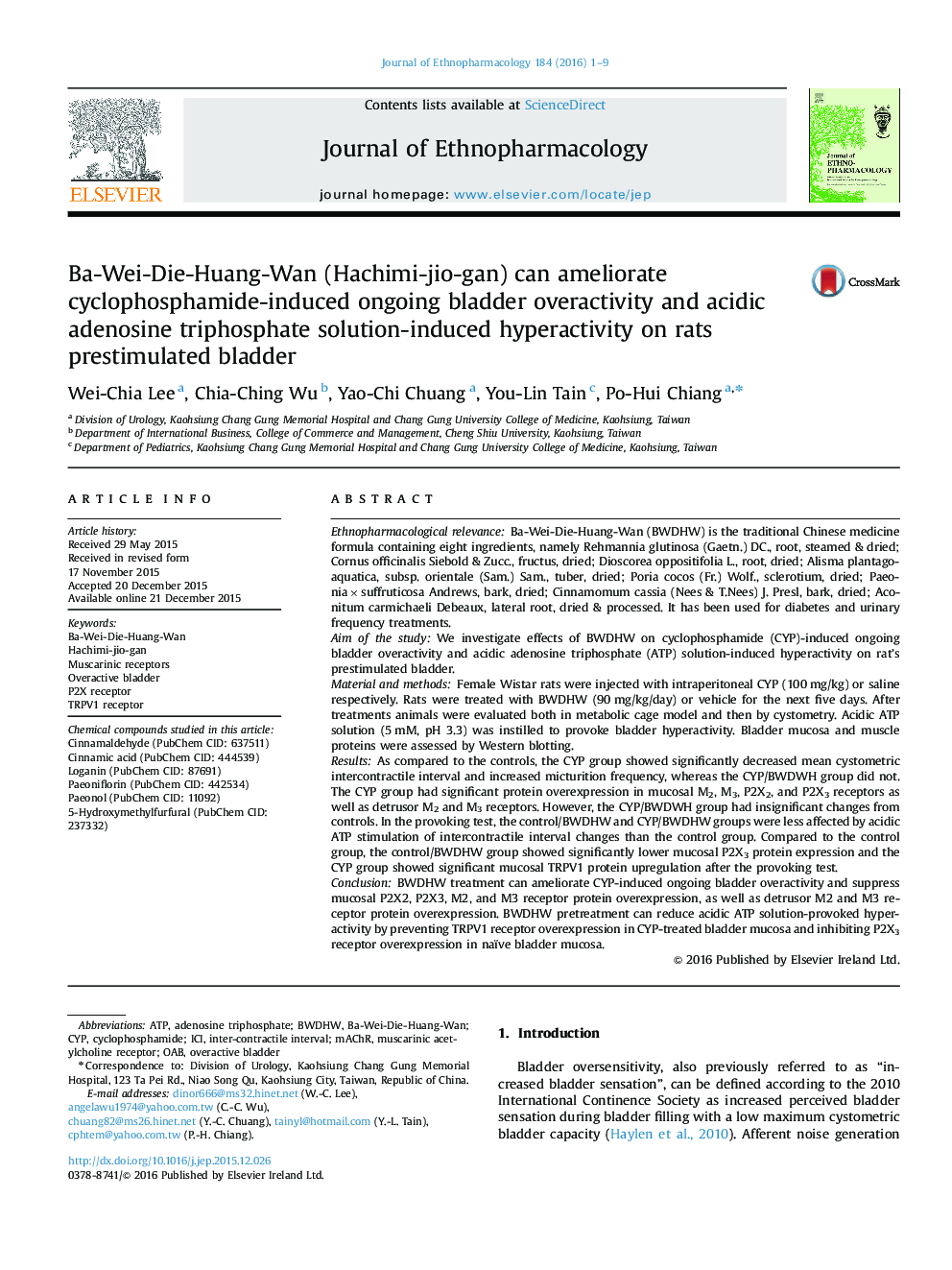| Article ID | Journal | Published Year | Pages | File Type |
|---|---|---|---|---|
| 2544772 | Journal of Ethnopharmacology | 2016 | 9 Pages |
Ethnopharmacological relevanceBa-Wei-Die-Huang-Wan (BWDHW) is the traditional Chinese medicine formula containing eight ingredients, namely Rehmannia glutinosa (Gaetn.) DC., root, steamed & dried; Cornus officinalis Siebold & Zucc., fructus, dried; Dioscorea oppositifolia L., root, dried; Alisma plantago-aquatica, subsp. orientale (Sam.) Sam., tuber, dried; Poria cocos (Fr.) Wolf., sclerotium, dried; Paeonia×suffruticosa Andrews, bark, dried; Cinnamomum cassia (Nees & T.Nees) J. Presl, bark, dried; Aconitum carmichaeli Debeaux, lateral root, dried & processed. It has been used for diabetes and urinary frequency treatments.Aim of the studyWe investigate effects of BWDHW on cyclophosphamide (CYP)-induced ongoing bladder overactivity and acidic adenosine triphosphate (ATP) solution-induced hyperactivity on rat’s prestimulated bladder.Material and methodsFemale Wistar rats were injected with intraperitoneal CYP (100 mg/kg) or saline respectively. Rats were treated with BWDHW (90 mg/kg/day) or vehicle for the next five days. After treatments animals were evaluated both in metabolic cage model and then by cystometry. Acidic ATP solution (5 mM, pH 3.3) was instilled to provoke bladder hyperactivity. Bladder mucosa and muscle proteins were assessed by Western blotting.ResultsAs compared to the controls, the CYP group showed significantly decreased mean cystometric intercontractile interval and increased micturition frequency, whereas the CYP/BWDWH group did not. The CYP group had significant protein overexpression in mucosal M2, M3, P2X2, and P2X3 receptors as well as detrusor M2 and M3 receptors. However, the CYP/BWDWH group had insignificant changes from controls. In the provoking test, the control/BWDHW and CYP/BWDHW groups were less affected by acidic ATP stimulation of intercontractile interval changes than the control group. Compared to the control group, the control/BWDHW group showed significantly lower mucosal P2X3 protein expression and the CYP group showed significant mucosal TRPV1 protein upregulation after the provoking test.ConclusionBWDHW treatment can ameliorate CYP-induced ongoing bladder overactivity and suppress mucosal P2X2, P2X3, M2, and M3 receptor protein overexpression, as well as detrusor M2 and M3 receptor protein overexpression. BWDHW pretreatment can reduce acidic ATP solution-provoked hyperactivity by preventing TRPV1 receptor overexpression in CYP-treated bladder mucosa and inhibiting P2X3 receptor overexpression in naïve bladder mucosa.
Graphical abstractFigure optionsDownload full-size imageDownload high-quality image (183 K)Download as PowerPoint slide
